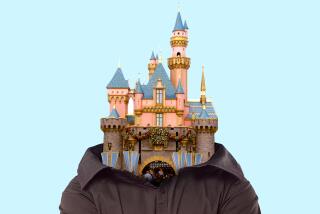A brighter Sleeping Beauty’s Castle is just one way Kim Irvine keeps the magic in Disneyland
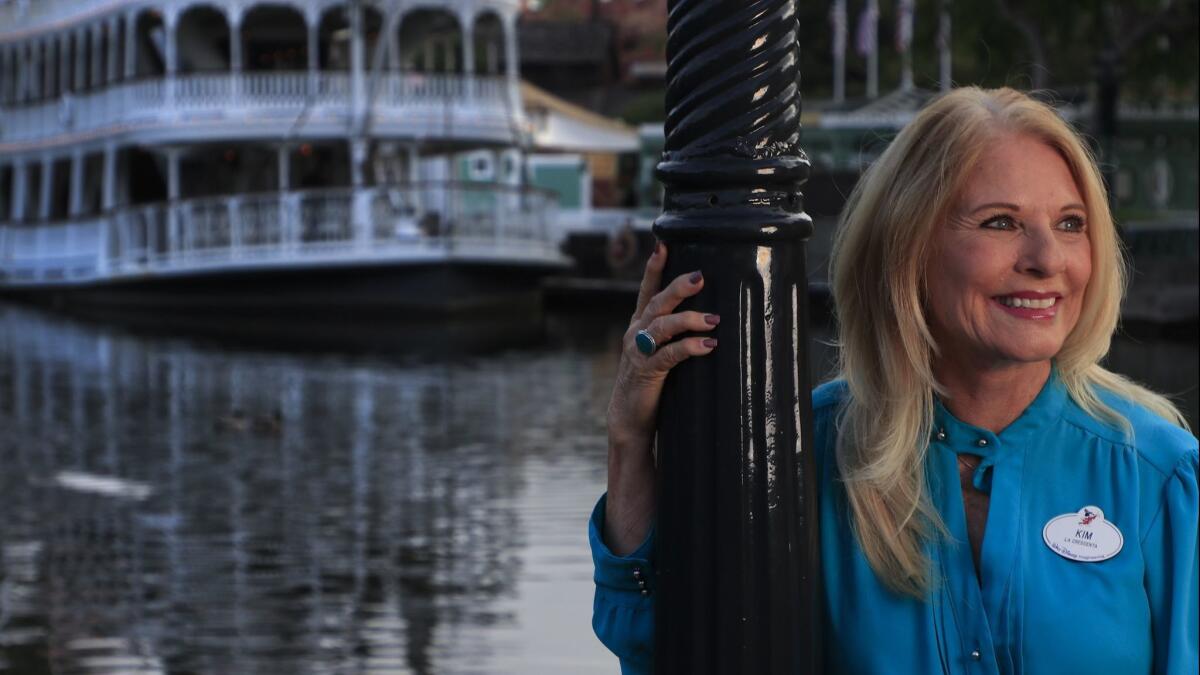
Here’s how deep Kim Irvine’s connections are to Disneyland: About three years before she started working for Walt Disney Imagineering, the creative arm of the company responsible for theme park experiences, the then-15-year-old simply wanted her mother to stop embarrassing her.
“Goblins and ghoulies from last Halloween,” Irvine says today, mimicking her mother and raising her voice as she leans forward in her chair in her Anaheim office.
For the record:
7:15 a.m. May 16, 2019An earlier version of this article stated that Kim Irvine began work in Florida’s model shop. While she was working on Florida’s Walt Disney World, she started at the Imagineering model shop in Glendale.
To many of Disneyland’s estimated 19 million or so annual visitors, these words are instantly recognizable as those of Madame Leota. It’s her disembodied head that floats in a crystal ball in the Haunted Mansion’s seance room, and it’s Madame Leota who sends visitors on their way with an eerie “hurrrry baaaack” as they exit the attraction.
Of course, Madame Leota, as devoted Disneyland fans know, is actually Leota Toombs, one of the first women to work for Imagineering, then known as WED Enterprises (for Walter Elias Disney). She is also Irvine’s mother. And on this day in the mid-’60s, Irvine wanted Mom to shush.
To be fair, Toombs did warn her daughter.
“She said, ‘I have three days now to learn this thing. I’m going to have to recite it, and they’re going to tie my head back so I don’t move. I have to do it with my eyes. I really have to practice this,’” Irvine says. “I was like, ‘OK, Mom.’
“I went out with my friends and we came home, and then from downstairs there’s ‘Goblins! Ghoulies!’ My friends were like, ‘What is up with your mom?’”
Disneyland isn’t just Irvine’s job; it’s a part of the 67-year-old’s family.
Toombs died in 1991, but her image and voice remain in the Mansion today. And when the park introduced a seasonal Nightmare Before Christmas holiday makeover for the ride, Irvine found herself taking the role as the face of Madame Leota.
For the last four decades, Irvine — art director at Walt Disney Imagineering — has led a team in Anaheim responsible for maintaining the look, tone and feel of Disney’s original park, which at the end of this month will open what’s billed as the largest expansion in its history, a single 14-acre land dedicated solely to “Star Wars.”
As Disneyland readies itself for its future, Irvine stands as a connection to the park’s beginnings. Her mission: to ensure that the company doesn’t forget its past; that’s evident in her current, and arguably most personal project: to repair and refurbish Disneyland’s centerpiece, Sleeping Beauty Castle.
During a year in which the Millennium Falcon will most likely become Disneyland’s most photographed attraction, Irvine set out to make the castle bolder and more colorful, as if to say, “Don’t forget your roots.” While Galaxy’s Edge will emphasize realism, with every staffer adopting a role in the land to give it a lived-in feel, Irvine describes her castle refresh as if she were putting a punctuation mark on Disneyland’s mission statement — to enter the worlds of yesterday, tomorrow and fantasy.
“When people come to Disneyland, they want it to be more fantastical,” she says, repeating a lesson passed down to her from John Hench, one of the park’s original designers, who would routinely tell Irvine to “push the color.”
“They want us to do things and use things that you wouldn’t see when you’re walking down the main street of your town,” she says. “This has got to be sweeter and more fantasy. So I keep that in mind. I’m not afraid of color at all. Ninety-nine percent of people are really afraid to use color in their decorating, or even buying a car — it’s black or white. It doesn’t scare me to do this.”
Some new flourishes, such as nightlight-like stars on the front roof of the castle, are already generating a debate; after a pause, she says, “I am afraid of the reaction people are going to have.”
Irvine’s role requires a certain fearlessness. Even a seemingly mundane assignment — spending the better part of the last few months overseeing a project to widen paths and create more breathing room for the crush of crowds expected for Galaxy’s Edge — can be fraught when one considers that the Disneyland fan base can react to the removal of a bench as if Sleeping Beauty Castle had been replaced by Avengers Tower.
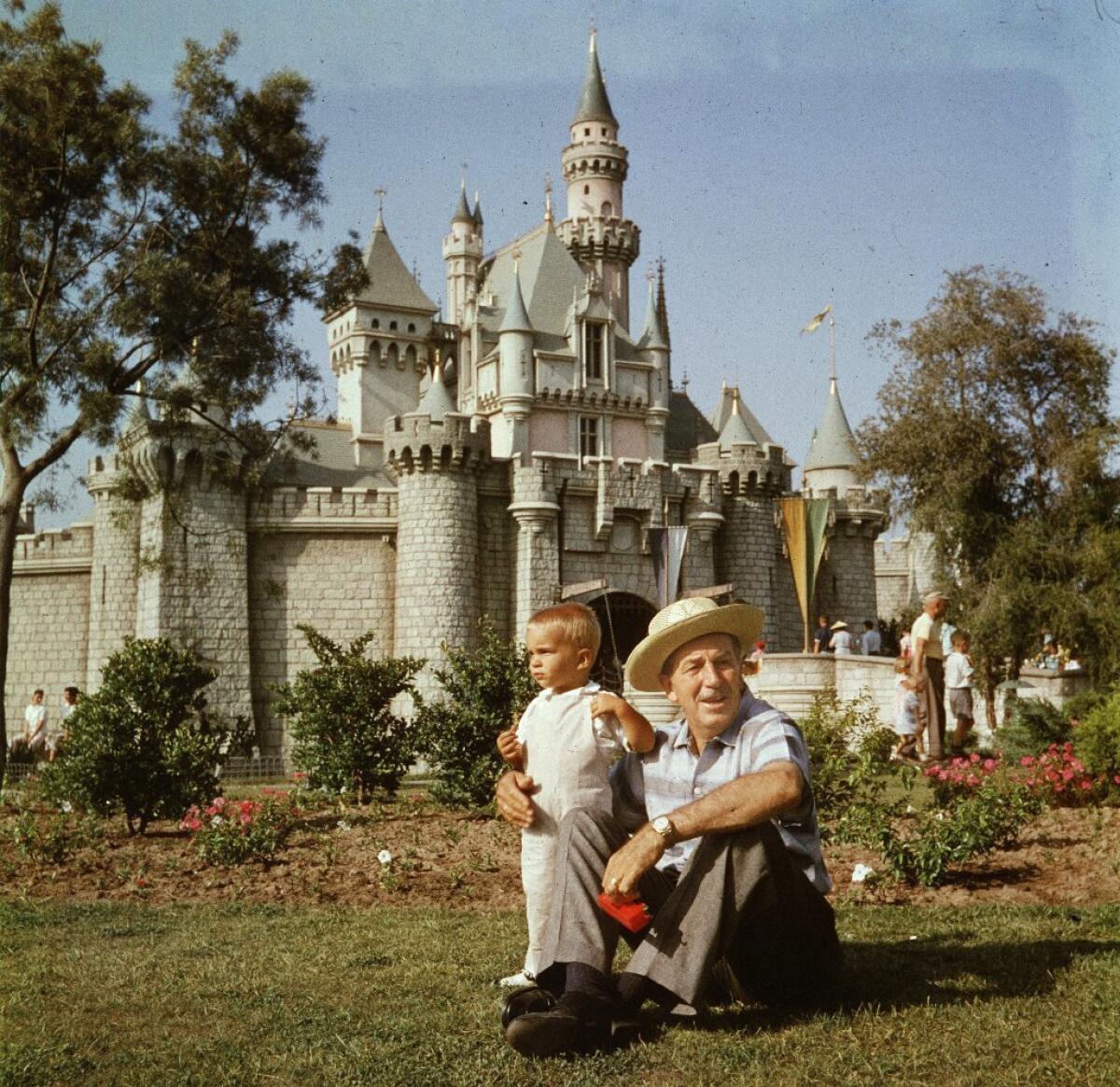
Irvine would know. Fans once called for her firing after Disney characters were added to It’s a Small World, an event that’s still traumatic for her to talk about. After all, one of Irvine’s first Imagineering jobs was working with Small World’s principal designer, Mary Blair, someone she considers an idol, on the Walt Disney World version of the attraction.
“Horrible,” she says of that period of her career. “Horrible. I go through it a lot. You know, we have a fan base that is so vocal about what they think is right or wrong for their heart, and I’ve been putting up with that for my entire career down here, which is almost 45 years.”
She laughs and adds, “So I’m getting used to it.”
Yet while Irvine has no control over the biggest gripes leveled at the park — it’s too expensive and too crowded — one could argue that she’s partly responsible for making Disneyland as appealing as it is.
In 1979, when Irvine — under the direction of Hench — sought to open the first Imagineering office in Anaheim, the park was lucky, she says, to attract 35,000 people in a day. It was, she adds, “kind of neglected,” as Imagineering and corporate interests had spent the previous decade focusing on the creation of Florida’s Walt Disney World.
“She wasn’t asked to do that,” retired Imagineer and legendary Disney artist Rolly Crump says of Irvine’s Anaheim outpost. “She just went and did it.”
Today, park attendance of 65,000 is a “normal” day, Irvine says.
Getting to her place of prominence in Imagineering wasn’t always easy. “It was all men,” Irvine says of the team at Disneyland in the late 1970s. “Quite frankly, there wasn’t a single woman, unless it was an assistant. And they were used to working on their own. They were used to having WED busy doing other things. They could kind of do their own thing. So it was like, ‘Who is this WED person down here telling us what to do? And she’s a girl?’”
Shortly after settling in Anaheim, Irvine worked with her Imagineering peers in Glendale to revamp Fantasyland and update Main Street, U.S.A. Since her arrival, no matter where the project originated, if it’s in Disneyland, Irvine has likely been involved in some fashion.
She has stewarded the park through the re-introduction of Abraham Lincoln and the arrival of “Star Wars” and “Indiana Jones” properties. Last year, she moved a river to accommodate Galaxy’s Edge.
Sleeping Beauty Castle will be fully revealed as soon as this weekend, days before the opening of Galaxy’s Edge. This is Irvine’s sixth castle refurbishment, but there’s no mistaking that this is the most important.
Irvine is emphasizing bright pink and darker blues — an illustration of “Sleeping Beauty” artist Eyvind Earle sprung to life, and a way to make the original designs of Herb Ryman pop. It’s a luminous and animation-friendly color palate, designed to more overtly look like something out of a storybook. It’s Irvine’s statement piece — a re-iteration that Disneyland must remain a place where fairy tales can flourish.
While Irvine can talk at length about which brick needs to be which color and why to maintain the castle’s illusion of height, she also wants the tops of its towers to match the cobalt blue currently seen in the animated intro that precedes all Disney films.
“It started out [that] the castle was very, very tan and beige,” says Irvine. “John Hench often walked by it and he would say, ‘We’ve got to fix that color scheme. An architect did that color scheme.’ It should be so much more, you know, colorful and bright.”
She says the castle has been keeping her up at night, largely because she won’t fully know what it looks like — and how it works up and down Main Street — until the scrims come off. Her coworkers aren’t concerned.
“The castle now looks like Kim to me,” says Michael Dobrzycki, who works with Irvine on the art direction of the park. “Most guests will enjoy this version of the castle without realizing that they are seeing the work of a world-class color stylist at the top of her game.”
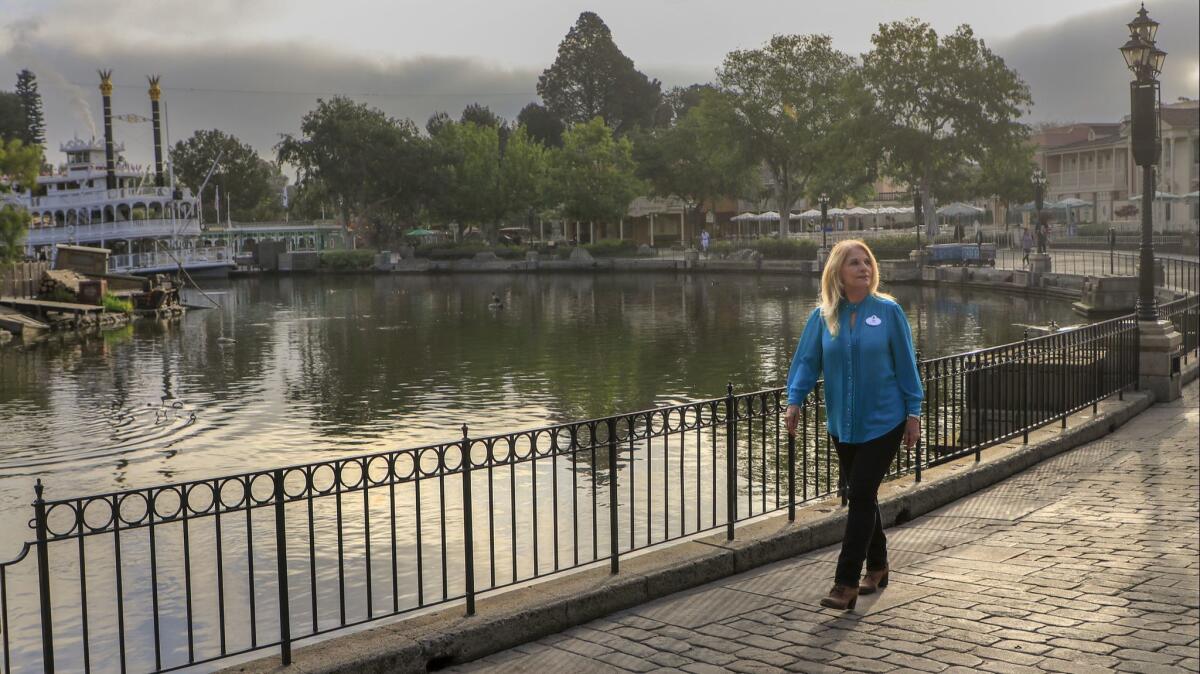
***
Irvine has been in her current office, about 2 miles from Disneyland, for three years. Previously, Imagineers stationed in Anaheim were huddled in trailers near the Haunted Mansion.
Though Irvine isn’t ready to retire yet, she knows the day isn’t far off. She repeatedly says her primary job today is mentoring her team, sharing the “tribal knowledge” passed down from her mother; Hench; her father, Disney animator Harvey Toombs; and her onetime father-in-law, Richard Irvine, who led Imagineering after Walt Disney’s death in 1966.
It’s not enough, Kim Irvine says, to know what kind of tree sits somewhere in the park; she wants her Imagineers to know every tree’s history — “that one was moved from downtown L.A. to make way for the freeway,” she says by way of hypothetical example.
“I just love this park. I really do,” she says, adding that she routinely rebuffed requests from the late Imagineering chief Marty Sklar to help open one of Disney’s international parks. “I go over there early in the morning to walk around quite a bit before the crowds come in, and I just look around, and I think it’s going to be so hard to leave this job. It’s going to be like moving away from home for the first time.”
Irvine’s office has the feel of a Disney library — if there’s an out-of-print book fans covet, it’s likely there. Scattered about are random knickknacks — the standard Disney and Mickey Mouse statues — but also bits of forgotten history.
Tucked almost under and behind a couch is an oddly sculpted statue of a cat, one with a slightly deformed face and elongated features. It was something she swiped from Imagineering’s original model shop, where, over the years, numerous Imagineers had gradually turned a friendly feline into something borderline creepy.
Things are more spacious in Imagineering’s current digs, which sit above Disney’s cast members-only outlet store. But one gets the sense that Irvine would prefer the trailers. It reminds her of when she started at the model shop, where every sculptor, costumer or designer did a bit of everything. It was an era when, as with any corporate art form before it became a billion-dollar industry, theme-park design was an apprenticeship rather than a carefully honed craft taught in universities.
It was there, in Glendale’s gymnasium-like model shop in 1971, that Irvine, who never went to college, came into contact with Crump, Blair, master sculptor Blaine Gibson, ace stylist Marc Davis and more. “People wore a lot of hats,” Irvine says. “You could sculpt with Blaine one day, and then you would build a model the next day, and the next day you would feather Tiki birds. You were never pigeonholed.”
Although she was nervous that other Imagineers would believe she’d gotten the job because of family connections, she immediately created fans. “She was over there with her mom and the other kids in the model shop,” recalls Crump, who was integral in designing the Enchanted Tiki Room and It’s a Small World. “That’s when I first met her. She was a Disney person. A lot of the other kids came in to do a job.”
Asked to define a “Disney person,” Crump admits it can be a bit abstract. But then he describes how Irvine in 2008 and 2009 was tasked with updating scenes to It’s a Small World, including the addition of multiple characters from Disney’s animated films.
“Kimmy called me and said, ‘Rolly, I’m concerned about having things other than Small World characters in there,’” recalls Crump, who as the ride’s principle designer created the famed kooky clock and facade. “She invited me to come down to tell her what I think. I was pleasantly surprised. I didn’t expect it to be done so softly. It was handled beautifully. If you’re going to make a change, then do a good job. The flavor is the same.”
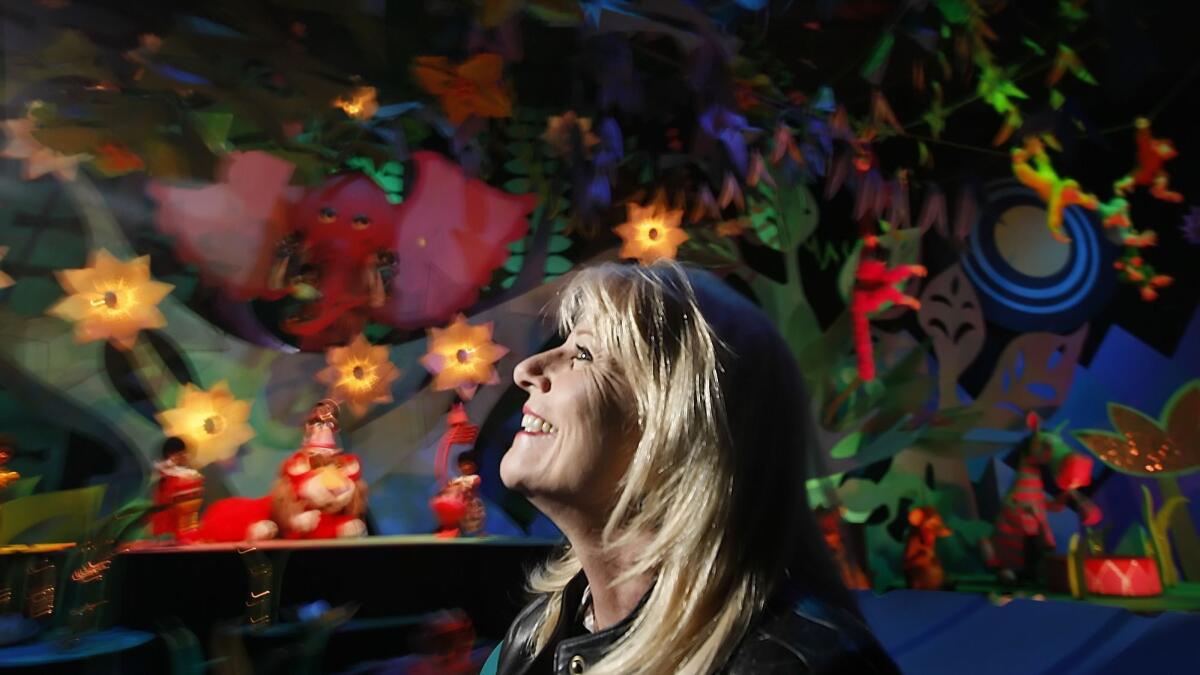
Knowing that Disneyland would always need tweaks and updates, and yet wanting the park to maintain a certain patina, is what inspired Irvine to open the Disneyland-based Imagineering office. In the late ’70s, Irvine says, decisions were made with little regard for the theatrics that Imagineering had once dreamed up.
“Because Imagineering was concentrating so much on other parks, their firstborn was getting kind of neglected,” Irvine says. “And it was much more maintenance-minded than it was show-minded at that time.
“The lighting in the park had gone just so south. It was so carefully designed with the right color lights and the right temperature and everything, and the electrician would basically run around with a bunch of lamps he had thrown in the back of the car. Whatever he had, he would screw into whatever was burned down. It lost its stories.”
The Irvine touch is sometimes invisible to guests. “Traditionally, I had selected plants based on where they were from in the world, but Kim taught me to also use plants for how they make you feel,” says longtime Disneyland landscape architect Julie Bush. She cites the compass in front of Sleeping Beauty Castle as a subtle but vital piece of Irvine’s work.
About two decades ago, much of the pebbled asphalt in front of the castle needed to be replaced. It was rough on the wheels of strollers and became a giant slip-zone when it rained. Here again, Irvine opted to “push the color,” using muted blues and pinks to make the compass more noticeable and to bring a fairy tale nature to the new concrete.
“Our castle compass is my favorite Kim design,” Bush says. “It was a very difficult design to build, with detailed brass lettering in colored concrete.”
Irvine knows that some Disneyland die-hards will bemoan the widening of the walkways to make room for Galaxy’s Edge — while trees have been moved, none have been removed, Irvine stresses, wanting to assuage any concerns that there will be less shade in the park.
She also never stops thinking of ways to use these large-scale projects to enhance the park or bring back something that has been lost, be it seating and dining in an underused area of Adventureland, returning original narration to Pirates of the Caribbean or lessening the blow of a shortened Rivers of America by creating a lush landscape full of waterfalls, a goal since she and others lost the battle to save the waterfall associated with the Mine Train Through Nature’s Wonderland, an early Frontierland attraction.
“I think Disneyland is so perfect,” Irvine says. “It’s not just the fans. It’s me too who says, ‘I really don’t want to change that.’”
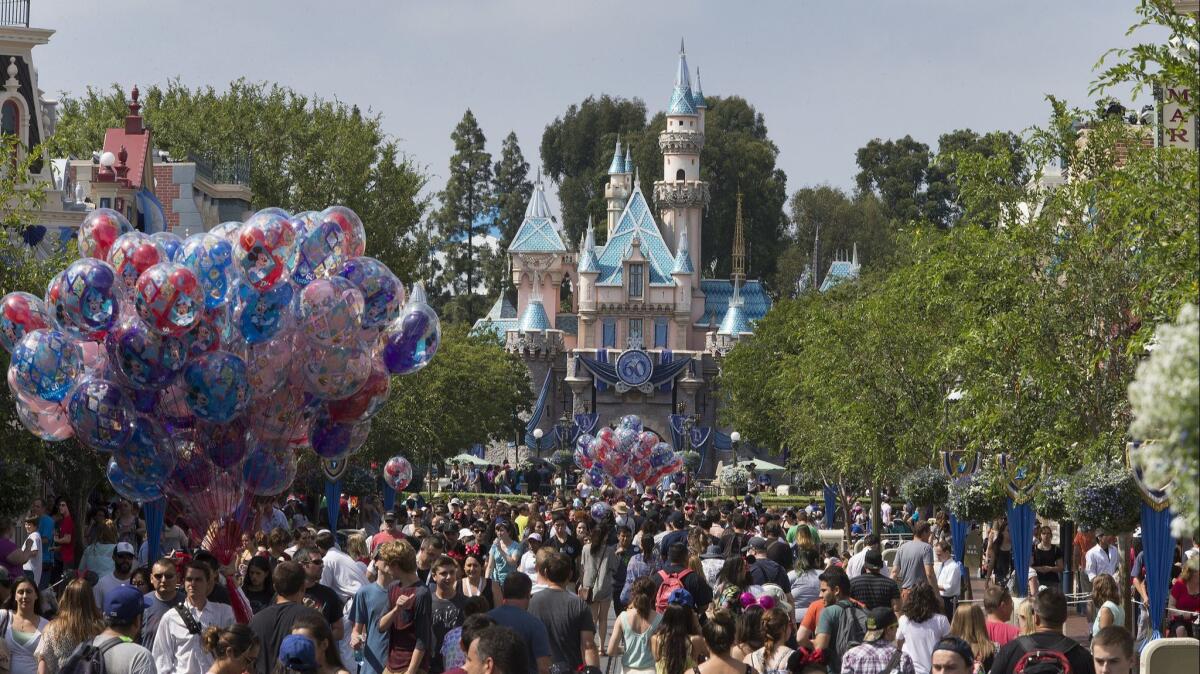
She appears relieved, for instance, when casually mentioning that requests over the decades to make Sleeping Beauty Castle larger were deemed impossible without irrevocably damaging its structure. And when asked whether there’s anything she’s touched that hasn’t been mentioned, instead of singling out a project or highlighting a fellow Imagineer, she stops to offer an apology.
In 2014, Irvine was tasked with expanding and remodeling the costly members-only Club 33; as part of that change, a quiet, serene and elegantly designed alcove in New Orleans Square, the Court of Angels, was closed off to regular guests. It was a move viewed by regulars as Disney catering to big spenders, forgetting that ordinary parkgoers need a place to sit and relax — or even propose — away from nosy, cheering crowds.
“There’s always been a part of me that felt badly about taking anything away,” Irvine says. “Taking away that Angels courtyard from our guests was really hard. It was a decision that was made, and I just had to try and make the best of it with the design of the doors and everything. That is something we try to never, ever do — to take a place that was theirs and turn it into something that they can no longer go to.”
Irvine is still working on a compromise. Though not ready to discuss it yet, she says, “we’re working on something right now.”
It’s a further sign that her goal of making sure Disney never loses sight of where it’s been won’t be finished when the tarps come off the castle.
“If I’m at the table,” Irvine says of business decisions that don’t feel right to her, she believes she can find a middle ground by reasoning. “‘I understand what you’re trying to get, but that that doesn’t fit in our story.’ We have to stay within the original intent. That was always [Hench’s] mantra. You can change things, update things, make them more relevant, but always with the original intent.
“Don’t forget those stories. Those are all laid out for you. It’s so simple, really.”
Follow me on Twitter: @toddmartens
More to Read
The biggest entertainment stories
Get our big stories about Hollywood, film, television, music, arts, culture and more right in your inbox as soon as they publish.
You may occasionally receive promotional content from the Los Angeles Times.


